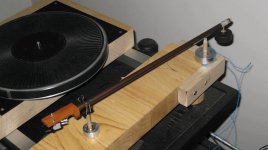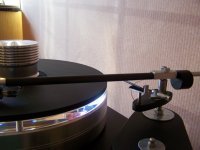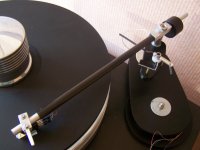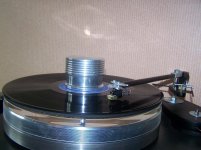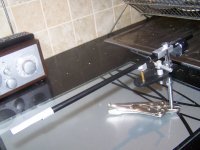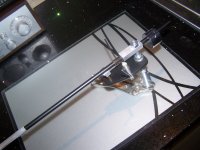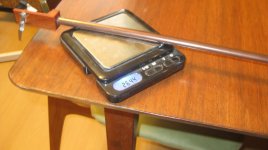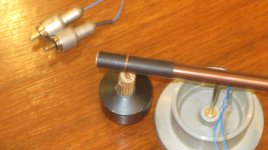Prior to attaching the arm wire to anything, at this point the arm wire was just wrapped around the arm tube, the counterweight was balancing the arm perfectly.
When in this state of equilibrium, the arm would gently rotate in any direction. But it would also Ocillayte from side to side or about the axis of the bearing, at the slightest provocation, Which when you think about it is a very good thing indeed as it shows very clearly how well the bearing is working.
What I didn't do was observe how the counterweight reacted, I think it allowed the arm tube to move freely but within a confined space.
When the arm was put onto a record the ocillaytion stopped almost immediately.
However, when the wire was introduced or rather connected It began to make its presence felt. So dressing of the arm wire is rather important with a Unipivot. a bit like the dressing of the arm wire inside the Linn.
Back to the counterweight.
In my case its NOT fixed in any way, Ill try to explain; It is suspended from the arm tube by fairly thick copper wire that is loose around the tube. So it will move about ( slightly & not good in itself ) at its point of contact, which is at the top of the tube. Perhaps this could be seen as a single point of contact, the same as an upside down Uni pivot !
But if this could be controlled so the weight would not slide about.
ie a dimple on the top of the tube....
Im thinking this idea might have legs....
Would this a good way to consider mounting the counterweight ?
When in this state of equilibrium, the arm would gently rotate in any direction. But it would also Ocillayte from side to side or about the axis of the bearing, at the slightest provocation, Which when you think about it is a very good thing indeed as it shows very clearly how well the bearing is working.
What I didn't do was observe how the counterweight reacted, I think it allowed the arm tube to move freely but within a confined space.
When the arm was put onto a record the ocillaytion stopped almost immediately.
However, when the wire was introduced or rather connected It began to make its presence felt. So dressing of the arm wire is rather important with a Unipivot. a bit like the dressing of the arm wire inside the Linn.
Back to the counterweight.
In my case its NOT fixed in any way, Ill try to explain; It is suspended from the arm tube by fairly thick copper wire that is loose around the tube. So it will move about ( slightly & not good in itself ) at its point of contact, which is at the top of the tube. Perhaps this could be seen as a single point of contact, the same as an upside down Uni pivot !
But if this could be controlled so the weight would not slide about.
ie a dimple on the top of the tube....
Im thinking this idea might have legs....
Would this a good way to consider mounting the counterweight ?
a good way....
Jay,
I've used similar set ups for the counter-weight. I even made a little "rack". I adjusted a screw so that a copper wire which was situated in the threads of the screw moved forwards or backwards in a very controlled way. I have also used something exactly as you described, except I just used some tape to allow the copper wire something to grip.
Jay,
I've used similar set ups for the counter-weight. I even made a little "rack". I adjusted a screw so that a copper wire which was situated in the threads of the screw moved forwards or backwards in a very controlled way. I have also used something exactly as you described, except I just used some tape to allow the copper wire something to grip.
Attachments
My iteration of Nanook's Arm
Hi Everyone
As promised a while ago, here is my version. Incorporated is the lift/lower device and the simple method of easily lifting and lowering the whole arm to get vta spot on without using shims etc. Sounds amazing!!
Chris
Hi Everyone
As promised a while ago, here is my version. Incorporated is the lift/lower device and the simple method of easily lifting and lowering the whole arm to get vta spot on without using shims etc. Sounds amazing!!
Chris
Attachments
Is that a Pickering?
Looks like an XV-15 without the brush tip
nicely done
Chris,
Looks very nicely done. Perhaps a little heavy...(but I prefer Grado cartridges, and the total mass of my arm works wonderfully with these). I have a similar aluminum headshell here as well. I think I'll try my hand at a Schroeder style one (such as your's using wood, cause I like wood .
.
The VTA adjustment is almost a moot point, how much adjustment is required? Perhaps 1" maximum. However having the ability to set the height of the tonearm makes it transferable to any turntable, more or less.
IT looks to be very well executed.
Chris,
Looks very nicely done. Perhaps a little heavy...(but I prefer Grado cartridges, and the total mass of my arm works wonderfully with these). I have a similar aluminum headshell here as well. I think I'll try my hand at a Schroeder style one (such as your's using wood, cause I like wood
The VTA adjustment is almost a moot point, how much adjustment is required? Perhaps 1" maximum. However having the ability to set the height of the tonearm makes it transferable to any turntable, more or less.
IT looks to be very well executed.
Last edited:
Hi Stew
Thanks for the comments. I have been refining this for a number of years-although this uses carbon fibre, I have obtained an arrow shaft-due for experimentation over the next couple of weeks-I'll let you know how that works out-initial thoughts are that it is very light but not as rigid as I thought it would be-but then-nothing ventured.....
Sound quality? Very detailed and natural with excellent, well-defined bass. Agree with you on vertical adjustment-it was so easy to use the method I have come up with-same thing that Simon in New Zealand has used with the Wand.
Thanks for the comments. I have been refining this for a number of years-although this uses carbon fibre, I have obtained an arrow shaft-due for experimentation over the next couple of weeks-I'll let you know how that works out-initial thoughts are that it is very light but not as rigid as I thought it would be-but then-nothing ventured.....
Sound quality? Very detailed and natural with excellent, well-defined bass. Agree with you on vertical adjustment-it was so easy to use the method I have come up with-same thing that Simon in New Zealand has used with the Wand.
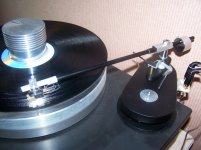
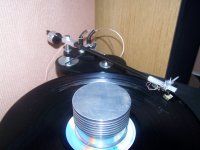
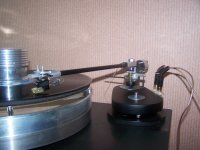
Hello Everyone
Took time away from the linear tracker to finish off the unipivot- and you know what? Arrow shafts rule!! As soon as I hooked it up I could tell there was something special there. I know I've drifted from Stew's original design with the hanging counterweight (have a few ideas of my own on this one-think Roksan's 'Zi' mod counterweight on the Tabriz) but I am mightily impressed with the results.
Chris
Anyone with a modicum of DIY skill can make one-it cost me next to nothing to make-come on, everyone start buying arrow shafts and get on with it........
Everybody jump in...
At least that's what I think. I'd be very interested in your listening impressions, and your complete system description. Please email me or PM me should you not want to post the information on the forum, and any comparisons (direct or from memory). I ask all that try this dirt simple tonearm to do the same. If need be, perhaps a "219 listening impressions" thread could be started.
The hanging counterweight is a good thing, and I suspect it is partially responsible for the good sound (I can present some arguments for this thinking). It does help lower the centre of gravity enough to stabilize the arm. I do use hanging counterweights myself.
MY thoughts exactly. My original though was to make an improved Altman DIY tonearm: better materials an more precise parts. You can make this on your kitchen table to a very high standard of performance. I do have issues regarding the machining of the arrow shafts and care that must be taken to minimize any possible hazards. Common sense should be exercised.
Chris, thanks for the kind words and the encouragement to others. I will state that a complete arm of my construction without a counterweight should weigh in at approximately 26.5 with all hardware (cartridge, cartridge screws, internal wiring, installed female bearing cup, headshell, and finger lift). I took some pictures of the my arm on a scale, but the digital scale readout can't be read via the photo.
Hello Everyone
Took time away from the linear tracker to finish off the unipivot- and you know what? Arrow shafts rule!! As soon as I hooked it up I could tell there was something special there.
At least that's what I think. I'd be very interested in your listening impressions, and your complete system description. Please email me or PM me should you not want to post the information on the forum, and any comparisons (direct or from memory). I ask all that try this dirt simple tonearm to do the same. If need be, perhaps a "219 listening impressions" thread could be started.
I know I've drifted from Stew's original design with the hanging counterweight (have a few ideas of my own on this one-think Roksan's 'Zi' mod counterweight on the Tabriz) but I am mightily impressed with the results.
The hanging counterweight is a good thing, and I suspect it is partially responsible for the good sound (I can present some arguments for this thinking). It does help lower the centre of gravity enough to stabilize the arm. I do use hanging counterweights myself.
Anyone with a modicum of DIY skill can make one-it cost me next to nothing to make-come on, everyone start buying arrow shafts and get on with it........
MY thoughts exactly. My original though was to make an improved Altman DIY tonearm: better materials an more precise parts. You can make this on your kitchen table to a very high standard of performance. I do have issues regarding the machining of the arrow shafts and care that must be taken to minimize any possible hazards. Common sense should be exercised.
Chris, thanks for the kind words and the encouragement to others. I will state that a complete arm of my construction without a counterweight should weigh in at approximately 26.5 with all hardware (cartridge, cartridge screws, internal wiring, installed female bearing cup, headshell, and finger lift). I took some pictures of the my arm on a scale, but the digital scale readout can't be read via the photo.
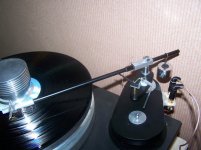
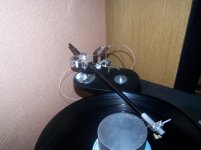
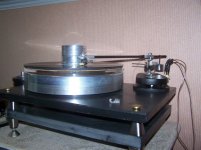
Here are some pictures with the counterweight as per Stew's design. I had the odd couple of minutes and thought it worth a try. Guess what? A resounding success!
I have owned a lot of quite expensive arms: Clearaudio Tangent, Opus 3 Cantus, Morch UP4, OL (different ones), Notts Analogue Mentor, Syrinx, Ittok, Kuzma Stogi unipivot etc........ This compares extremely well and betters most of them.
Great detail and space, excellent tracking, low surface noise............
Anyone who doesn't have a try at making this doesn't know what they are missing. You will (I hope) understand that I know what I'm talking about- the deck in the picture began life as an LP12-it's much better now by the way.
Go on-take up archery and you'll never look back- no bull! Pardon the pun.
wow! That's a pretty "heady" endorsement...
Chris: please PM me.
Well Chris I can't say that I've owned a lot of good arms, but have a had a few and have listened to a lot.. A Sumiko Premier MMT(as installed on my Oracle Alex MkII), a SME IIIS (bought as an "upgrade to the MMT, but wasn't), a Linn Akito II (improved, "MC suitable" unlike the original Akito and Basic Linn arms) and my SME 309 (bought as an insurance replacement for the IIIS and still residing on my now old Alexandria). I think that as is (no internal dampening just the plain old shaft), the 219 betters 2 or 3 and matches the '309 in performance (it may be better it but comes down to personal taste and cartridge matching). At least it is in the same ballpark . And adding mass to the arm can be very easy to adjust for compatibility with heavier and/or more compliant cartridges than the Ortofon MC-3 Turbo or the Grado Sig* MCZ that I like so much. With heavier or more compliant cartridges internal dampening may be required.
. And adding mass to the arm can be very easy to adjust for compatibility with heavier and/or more compliant cartridges than the Ortofon MC-3 Turbo or the Grado Sig* MCZ that I like so much. With heavier or more compliant cartridges internal dampening may be required.
My complete 12" arm with (Grado) cartridge, mounting screws, finger lift, headshell and internal wiring is about 26.5 grams.
The "hung" counter-weight as pictured in Chris' last photos is essentially what I started with. I have looked at the Tabriz Zi counterweight and it does seem that it could be good, but I'd have to get a friend (Mike) to make me one.
Chris: please PM me.
Well Chris I can't say that I've owned a lot of good arms, but have a had a few and have listened to a lot.. A Sumiko Premier MMT(as installed on my Oracle Alex MkII), a SME IIIS (bought as an "upgrade to the MMT, but wasn't), a Linn Akito II (improved, "MC suitable" unlike the original Akito and Basic Linn arms) and my SME 309 (bought as an insurance replacement for the IIIS and still residing on my now old Alexandria). I think that as is (no internal dampening just the plain old shaft), the 219 betters 2 or 3 and matches the '309 in performance (it may be better it but comes down to personal taste and cartridge matching). At least it is in the same ballpark
My complete 12" arm with (Grado) cartridge, mounting screws, finger lift, headshell and internal wiring is about 26.5 grams.
The "hung" counter-weight as pictured in Chris' last photos is essentially what I started with. I have looked at the Tabriz Zi counterweight and it does seem that it could be good, but I'd have to get a friend (Mike) to make me one.
a picture or two of a dangling weight and the scale measurement
OK, here's a picture or two...
I had to enhance the picture of the scale reading as it was unreadable unless absolutely huge and zoomed in, but it is THE TRUTH. The "dangling weight" picture shows how I did that: here I used some solid copper wire and knotted it to a piece of dowel that goes through the centre of a salvaged counter-weight. Good thread would do the job (perhaps even better). Once the tracking force is adjusted via a scale, the azimuth can be adjusted by moving the knot in relation to the arm so that it grabs the arm in a different location. Simple, but it works. I had originally just used tape to provide some level of friction to hold the counter-weight in-situ, but here you see some 3/8" heat-shrink tubing installed on the arm.
OK, here's a picture or two...
I had to enhance the picture of the scale reading as it was unreadable unless absolutely huge and zoomed in, but it is THE TRUTH. The "dangling weight" picture shows how I did that: here I used some solid copper wire and knotted it to a piece of dowel that goes through the centre of a salvaged counter-weight. Good thread would do the job (perhaps even better). Once the tracking force is adjusted via a scale, the azimuth can be adjusted by moving the knot in relation to the arm so that it grabs the arm in a different location. Simple, but it works. I had originally just used tape to provide some level of friction to hold the counter-weight in-situ, but here you see some 3/8" heat-shrink tubing installed on the arm.
Attachments
Counterweight weight
Hi there N: The counter weight looks large, is it still 88grams (slug, dowel, wire)? After your explanation, I now understand the reason for underhanging counterweight
...regards, Michael
OK, here's a picture or two...
I had to enhance the picture of the scale reading as it was unreadable unless absolutely huge and zoomed in, but it is THE TRUTH. The "dangling weight" picture shows how I did that: here I used some solid copper wire and knotted it to a piece of dowel that goes through the centre of a salvaged counter-weight. Good thread would do the job (perhaps even better). Once the tracking force is adjusted via a scale, the azimuth can be adjusted by moving the knot in relation to the arm so that it grabs the arm in a different location. Simple, but it works. I had originally just used tape to provide some level of friction to hold the counter-weight in-situ, but here you see some 3/8" heat-shrink tubing installed on the arm.
Hi there N: The counter weight looks large, is it still 88grams (slug, dowel, wire)? After your explanation, I now understand the reason for underhanging counterweight
...regards, Michael
small counter-weight...
I'm assuming it is the 80 gram range, as my scale only reads to 50 grams or so. Dimensions are 31mm (diameter) X 18mm (high). The centre hole is 10mm (diameter). The dowel could be trimmed down and thread could be used instead of solid core copper wire. The weight savings might be a couple of grams....
I'm assuming it is the 80 gram range, as my scale only reads to 50 grams or so. Dimensions are 31mm (diameter) X 18mm (high). The centre hole is 10mm (diameter). The dowel could be trimmed down and thread could be used instead of solid core copper wire. The weight savings might be a couple of grams....
Hi guys,
Just back from Italy mmm good coffee & so cheep in comparison to the exstortinstly priced rubbish we get hear.
Anyway as to arms.
Did I miss something about how to make an easy VTA, adjustable arm ??
Would be very interested in any designs .
The on ly arms that seem to display simple on the fly VTA also seem to use micrometers, which could be a bit pricy for what we are doing !
So something for all to think about
Jay
Just back from Italy mmm good coffee & so cheep in comparison to the exstortinstly priced rubbish we get hear.
Anyway as to arms.
Did I miss something about how to make an easy VTA, adjustable arm ??
Would be very interested in any designs .
The on ly arms that seem to display simple on the fly VTA also seem to use micrometers, which could be a bit pricy for what we are doing !
So something for all to think about
Jay
on the fly VTA adjustment...
Jay,
nope you haven't really missed much, just some discussion.
VTA is usually correct when the arm is parallel to the record (So sez SME ). VTA adjustment on-the-fly is beyond what should be done, considering the low buy-in to this arm. Do as your conscience tells you, but I don't thing uni-pivots work well with on-the-fly VTA adjustments. Any sort of locking collar with a set screw can be made to work easily enough so that there is an adjustable VTA, or a similar mount to Chris'.
). VTA adjustment on-the-fly is beyond what should be done, considering the low buy-in to this arm. Do as your conscience tells you, but I don't thing uni-pivots work well with on-the-fly VTA adjustments. Any sort of locking collar with a set screw can be made to work easily enough so that there is an adjustable VTA, or a similar mount to Chris'.
Jay,
nope you haven't really missed much, just some discussion.
VTA is usually correct when the arm is parallel to the record (So sez SME
- Status
- This old topic is closed. If you want to reopen this topic, contact a moderator using the "Report Post" button.
- Home
- Source & Line
- Analogue Source
- my latest iteration of "Nanook's 219 tonearm"..
